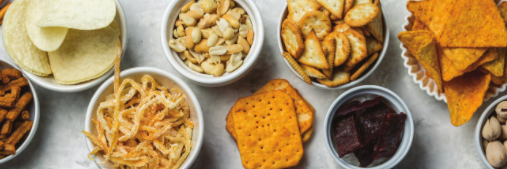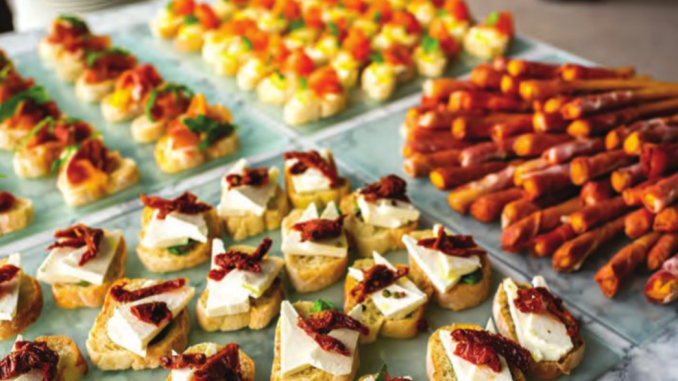Tips to Move Snacks
December 1, 2020 | 7 min to read
Delis are evolving into snack destinations, with a notable rise in sales for pre-packaged items, particularly meats and cheeses. According to Eric Richard of the IDDBA, consumers favor single-serve packs for their convenience and hygiene, driving the popularity of items like pickles. Manufacturers, like Van Holten’s, highlight the appeal of pickle pouches and the trend toward health-conscious, keto-friendly snacks. Notably, spicy varieties, such as the Tapatio pickle, resonate with younger consumers.

Delis are the perfect place for snacks. This department offers both refrigerated and shelf stable merchandising options. It is a place consumers look to for new and innovative products. Also, the department has endless cross merchandising opportunities to increase basket rings.
“For delis, sales have been pretty good specifically for meat and cheeses as snacks,” says Eric Richard, industry relations coordinator at the International Dairy-Deli-Bakery Association (IDDBA), based in Madison, WI. “People are still buying and eating the same food, especially those working from home.”
With much of the department’s self-serve areas shut down, consumers are gravitating toward pre-packaged snack items and pre-sliced meats and cheeses.
Here, Deli Business talks to manufacturers about the appropriate steps to take to make the deli department a snack destination.
Single Serve Success
“The biggest thing we’re seeing in growth across the board is sales are phenomenal for single-serve packs,” says Eric Girard, vice president of sales and marketing at Van Holten’s, headquartered in Waterloo, WI. “UPC items are very popular from a health and sanitation standpoint versus a pickle barrel program.”
With consumers’ eating patterns shifted due to the pandemic, not only are they in search of prepackaged items, but they also are avoiding carbs. For this reason, pickles in particular are seeing an uptick in sales.
“It’s a sanitary, food safe, single service item that contains no gluten or excess sugar,” he says. “It’s also Keto friendly, carb free and a guilt-free snack.”
As for the format, pickle cuts and the pickle in a pouch are benefitting from the current trends.
“In delis, we are typically sold as an accoutrement with a sandwich, rather than as an ingredient in it,” says Girard.
Van Holten’s is focusing on its single-serve pickle in a pouch as well as slices, and the perception of fresh is more prevalent in the deli as compared to the grocery aisle.
“We are definitely placed in the deli section, which fits a customers’ higher expectation for products,” says Girard. “The benefit to a single-serve pickle is that it can be taken on the go as part of a lunch or as a side to a sandwich or meal. It can build a basket ring, as well.”
Because Van Holten’s pickle pouches stand upright, they can be easily merchandised in the cooler at the center of the deli department.
Up-and-coming products include spicy varieties, such as the Tapatio pickle, which combines Tapatio hot sauce with Van Holten’s pickle in a pouch.
“This is our most popular in the West and skews well with Millennials,” says Girard. “It’s a very popular hot sauce.”

Focusing on Health
Healthy snacking has been a long-term trend but has come even more to the forefront in recent months.
“People are more health conscious than 20 or 30 years ago, and are looking for less processed, more natural snack products,” says Greg Thorsgard, COO of Hazelnut Growers of Oregon, Aurora, OR. “Eating a cracker is good but how many iterations have they been through?”
By comparison, nuts are a popular snack that have a long shelf life and holds their nutritional value. Nuts are not only filled with omegas and fatty acids but are a good vehicle for protein.
“Almonds have done the best job with marketing and building customer awareness, followed by pistachios, which come in different formats—shelled partially or completely,” says Thorsgard.
Another benefit to nuts is these are completely transportable and easy to eat on the go.
“Nuts don’t take a lot of special care or packaging,” he says.
Recently, the nut category has expanded in terms of snacks. Following the popularity of pistachios and pecans is hazelnuts. Unfortunately, consumer awareness for this product remains low.
“We’re coming out with a wide variety of hazelnut snacks for supermarket delis’ grab-and-go sections,” says Thorsgard. “The snack realm for these products is not going away, especially now with consumers eating more small meals and snacks as meal replacements.”
He says the key to marketing nuts and other like products in deli departments is concentrating on smaller sizes that are portable as well as a wide range of options.
“Providing nut options increases consumption,” he says. “Items geared for more immediate consumption rather than for stocking up should be the focus. This has to be taken into account when looking at a snack item’s format.”
Kudos to Combos
Just like meal kits, snack kits have become more popular and are now ubiquitous in deli departments.
“One item that has done well for us is the Hollywood Snack,” says Jason Carroll, president of Lifestyle Foods, headquartered in Breil, PA. “This combines cheese, pretzels, grapes and apples in one container.”
The refrigerated item is sold in deli grab-and-go areas.
“It appeals to all crowds, but kids and moms primarily,” says Carroll.
Of its nine snack packs, Lifestyle Foods’ top three are the Hollywood, the Essential—with a mini whole wheat bagel, reduced fat cream cheese, a peeled hard boiled egg, grapes and apples—and the Manhattan, which has roasted red pepper hummus, mini whole wheat pitas, carrots and cheese cubes. Each combo is about 200 calories total.
“This is all we do, and the space has become pretty competitive in recent years,” says Carroll.
“More meat and cheese companies are creating combo packs with crackers, and we’ve focused on more fresh product.”
The snack packs’ shelf life is two weeks. The compartmented tray easily fits on a lap, and each section is sealed separately. The packaging is clear, providing complete visibility to the contents.
“The snack packs are an evolving trend that will continue to expand,” says Carroll. “It is geared toward more healthy items, too, so this will continue to grow.”
An Eye on Ingredients
With food sensitivities at the forefront, there has been an increased focus on snack ingredients, and this includes those items sold in the supermarket deli.
Bakery Street, based in San Leandro, CA, was founded in the mid 80s and the majority of its product line began with Asian almond cookies.
“Our focus was on all-natural product, and recently we have branched out into the Keto world,” says Aaron Chua, the company’s vice president of sales. “Over the past few years, we saw a trend toward more conscious eating, with Paleo, organics, etc. Everyone is learning the basics of macros and watching what they eat.”
Many of Bakery Street’s products are bakery category items, but there is a huge potential in the deli department.
“We did launch a Keto line with larger product sizes, and many supermarkets are picking up on the trend for these products,” says Chua. “Especially with COVID, people are more likely to go to local supermarkets and looking for something to eat and finish rather than save it.”
Bakery Street’s most popular item is its almond Keto bite, and its newest product is cinnamon pecan launched this past fall.
“One flavor we’re launching this summer is brownie Keto bites,” says Chua. “Keto is about watching net carbs, and 99% of consumers who follow it don’t eat wheat or traditional flours or added sugar.”
As for ingredients, Bakery Street uses erythritol as a sugar substitute and almond flour.
“One thing we notice with Keto is overarching with net carbs, and fat is not as important,” says Chua. “When we developed our products, we take the limitations into account, so we don’t add eggs or milk or anything that affects saturated fat. The only saturated fat is coming from almonds.”
Over the past year, the company has been working on beefing up its social media, and also provides fact sheets and nutritionals.
“We talk about why our product is different,” says Chua. “We have core food that makes up the majority of meals for the day, but we’re all looking for things to snack on.” DB
5 of 9 article in DeliBusiness Dec 2019/Jan 2020

